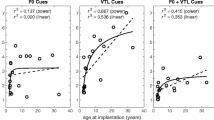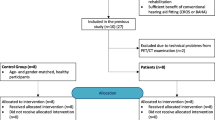Abstract
Most cochlear implantations are unilateral. To explore the benefits of a binaural cochlear implant, we used water-labelled oxygen-15 positron emission tomography. Relative cerebral blood flow was measured in a binaural implant group (n = 11), while the subjects were passively listening to human voice sounds, environmental sounds non-voice or silence. Binaural auditory stimulation in the cochlear implant group bilaterally activated the temporal voice areas, whereas monaural cochlear implant stimulation only activated the left temporal voice area. Direct comparison of the binaural and the monaural cochlear implant stimulation condition revealed an additional right temporal activation during voice processing in the binaural condition and the activation of a right fronto-parietal cortical network during sound processing that has been implicated in attention. These findings provide evidence that a bilateral cochlear implant stimulation enhanced the spectral cues associated with sound perception and improved brain processing of voice stimuli in the right temporal region when compared to a monaural cochlear implant stimulation. Moreover, the recruitment of sensory attention resources in a right fronto-parietal network allowed patients with bilateral cochlear implant stimulation to enhance their sound discrimination, whereas the same patients with only one cochlear implant stimulation had more auditory perception difficulties.

Similar content being viewed by others
References
Shannon RV, Zeng FG, Kamath V, Wygonski J, Ekelid M (1995) Speech recognition with primarily temporal cues. Science 270:303–304
Wilson BS, Dorman MF (2008) Cochlear implants: a remarkable past and a brilliant future. Hear Res 242:3–21
Moore DR, Shannon RV (2009) Beyond cochlear implants: awakening the deafened brain. Nat Neurosci 12:686–691
Mosnier I, Sterkers O, Bebear JP, Godey B, Robier A et al (2009) Speech performance and sound localization in a complex noisy environment in bilaterally implanted adult patients. Audiol Neurootol 14:106–114
Bronkhorst AW, Plomp R (1988) The effect of head-induced interaural time and level differences on speech intelligibility in noise. J Acoust Soc Am 83:1508–1516
Dillion H (2001) Binaural and bilateral considerations in hearing aid fitting. In: Thième NY (ed) Hearing aids. Boomerang Press, Sydney, pp 370–403
Aggarwal R, Green KM (2012) Cochlear implants and positron emission tomography. J Laryngol Otol 126:1200–1203
Green KM, Julyan PJ, Hastings DL, Ramsden RT (2011) Cortical activations in sequential bilateral cochlear implant users. Cochlear Implants Int 12:3–9
Strelnikov K, Rouger J, Eter E, Lagleyre S, Fraysse B et al (2011) Binaural stimulation through cochlear implants in postlingual deafness: a positron emission tomographic study of word recognition. Otol Neurotol 32:1210–1217
Coez A, Zilbovicius M, Ferrary E, Bouccara D, Mosnier I et al (2008) Cochlear implant benefits in deafness rehabilitation: PET study of temporal voice activations. J Nucl Med 49:60–67
Coez A, Zilbovicius M, Ferrary E, Bouccara D, Mosnier I et al (2009) Processing of voices in deafness rehabilitation by auditory brainstem implant. Neuroimage 47:1792–1796
Belin P, Zatorre RJ, Lafaille P, Ahad P, Pike B (2000) Voice-selective areas in human auditory cortex. Nature 403:309–312
Fox PT, Mintun MA, Raichle ME, Herscovitch P (1984) A noninvasive approach to quantitative functional brain mapping with H2 (15)O and positron emission tomography. J Cereb Blood Flow Metab 4:329–333
Bendriem B, Dahlbom M, Trebossen R (1996) Evaluation of the ECAT EXACT HR+: a new positron camera with 2D/3D acquisition capabilities and nearly isotropic spatial resolution [abstract]. J Nucl Med 37(suppl):170P
Talairach J, Tournoux P (eds) (1988) Co-planar stereotaxic atlas of the human brain: 3-dimensional proportional system—an approach to cerebral imaging. Thieme Medical, New York
Friston KJ, Worsley KJ, Poline JB, Frith CD, Frackowiak RS (1995) Statistical parametric maps in functional imaging: a general linear approach. Hum Brain Mapp 2:189–210
Massida Z, Belin P, James C, Rouger J, Fraysse B et al (2011) Voice discrimination in cochlear-implanted deaf subjects. Hear Res 275:120–129
Strelnikov K, Massida Z, Rouger J, Belin P, Barone P (2011) Effects of vocoding and intelligibility on the cerebral response to speech. BMC Neurosci 12:122
Friesen LM, Shannon RV, Baskent D, Wang X (2001) Speech recognition in noise as a function of the number of spectral channels: comparison of acoustic hearing and cochlear implants. J Acoust Soc Am 110:1150–1163
Zatorre RJ, Gandour JT (2008) Neural specializations for speech and pitch: moving beyond the dichotomies. Philos Trans R Soc Lond B Biol Sci 363:1087–1104
Schonwiesner M, Rubsamen R, von Cramon DY (2005) Spectral and temporal processing in the human auditory cortex—revisited. Ann N Y Acad Sci 1060:89–92
Zatorre RJ, Belin P (2001) Spectral and temporal processing in human auditory cortex. Cereb Cortex 11:946–953
Sidtis JJ, Volpe BT (1988) Selective loss of complex-pitch or speech discrimination after unilateral lesion. Brain Lang 34:235–245
Zatorre RJ (1985) Discrimination and recognition of tonal melodies after unilateral cerebral excisions. Neuropsychologia 23:31–41
Nakamura K, Kawashima R, Sugiura M, Kato T, Nakamura A et al (2001) Neural substrates for recognition of familiar voices: a PET study. Neuropsychologia 39:1047–1054
von Kriegstein K, Eger E, Kleinschmidt A, Giraud AL (2003) Modulation of neural responses to speech by directing attention to voices or verbal content. Brain Res Cogn Brain Res 17:48–55
Belin P, Zatorre RJ (2003) Adaptation to speaker’s voice in right anterior temporal lobe. Neuroreport 14:2105–2109
Belin P, McAdams S, Smith B, Savel S, Thivard L et al (1998) The functional anatomy of sound intensity discrimination. J Neurosci 18:6388–6394
Belin P, McAdams S, Thivard L, Smith B, Savel S et al (2002) The neuroanatomical substrate of sound duration discrimination. Neuropsychologia 40:1956–1964
Bestelmeyer PE, Latinus M, Bruckert L, Rouger J, Crabbe F et al (2012) Implicitly perceived vocal attractiveness modulates prefrontal cortex activity. Cereb Cortex 22:1263–1270
Acknowledgments
We thank the Beaujon Hospital clinical team for their assistance and the patients for their participation in this study. This work was supported by the Institut National de la Santé et de la Recherche Médicale, Inserm, France, and the Commissariat à l’Energie Atomique, CEA, France. The authors declare that they have no competing financial interests.
Conflict of interest
No duality of interest to declare.
Author information
Authors and Affiliations
Corresponding author
Rights and permissions
About this article
Cite this article
Coez, A., Zilbovicius, M., Ferrary, E. et al. Brain voice processing with bilateral cochlear implants: a positron emission tomography study. Eur Arch Otorhinolaryngol 271, 3187–3193 (2014). https://doi.org/10.1007/s00405-013-2810-8
Received:
Accepted:
Published:
Issue Date:
DOI: https://doi.org/10.1007/s00405-013-2810-8




